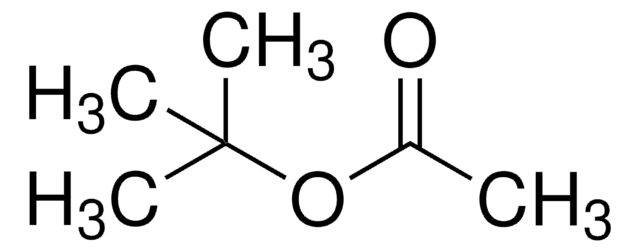24127
terc-Butanol
≥99% (GC)
Sinónimos:
2-Metil-2-propanol, Alcohol terc-butilo, Trimetil carbinol
About This Item
Productos recomendados
densidad de vapor
2.5 (vs air)
presión de vapor
31 mmHg ( 20 °C)
44 mmHg ( 26 °C)
Análisis
≥99% (GC)
formulario
liquid
temp. de autoignición
896 °F
lim. expl.
8 %
impurezas
≤0.001% free acid (as C3H7COOH)
≤0.001% non-volatile matter
≤0.1% water (Karl Fischer)
índice de refracción
n20/D 1.387 (lit.)
pH
7 (20 °C)
bp
83 °C (lit.)
mp
23-26 °C (lit.)
densidad
0.775 g/mL at 25 °C (lit.)
cadena SMILES
CC(C)(C)O
InChI
1S/C4H10O/c1-4(2,3)5/h5H,1-3H3
Clave InChI
DKGAVHZHDRPRBM-UHFFFAOYSA-N
¿Está buscando productos similares? Visita Guía de comparación de productos
Descripción general
Aplicación
It can be used for the butylation of p-cresol in the presence of 12-tungstophosphoric acid supported on zirconia catalyst. 2-tert-Butyl-p-cresol (TBC), 2,6-di-tert-butyl-p-cresol (DTBC) and tert-butyl-p-tolyl ether (ether) are formed as butylation reaction products.
Palabra de señalización
Danger
Frases de peligro
Consejos de prudencia
Clasificaciones de peligro
Acute Tox. 4 Inhalation - Eye Irrit. 2 - Flam. Liq. 2 - STOT SE 3
Órganos de actuación
Central nervous system, Respiratory system
Código de clase de almacenamiento
3 - Flammable liquids
Clase de riesgo para el agua (WGK)
WGK 1
Punto de inflamabilidad (°F)
59.0 °F - closed cup
Punto de inflamabilidad (°C)
15 °C - closed cup
Certificados de análisis (COA)
Busque Certificados de análisis (COA) introduciendo el número de lote del producto. Los números de lote se encuentran en la etiqueta del producto después de las palabras «Lot» o «Batch»
¿Ya tiene este producto?
Encuentre la documentación para los productos que ha comprado recientemente en la Biblioteca de documentos.
Los clientes también vieron
Nuestro equipo de científicos tiene experiencia en todas las áreas de investigación: Ciencias de la vida, Ciencia de los materiales, Síntesis química, Cromatografía, Analítica y muchas otras.
Póngase en contacto con el Servicio técnico





